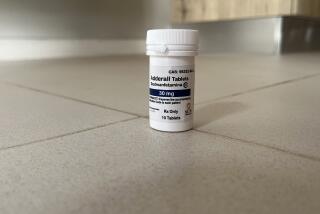Legal and Lethal
- Share via
Slade, a student at Thomas S. Wootton High School in Rockville, Md., usually waited until lunch before approaching a couple of buddies at school. When the time came he said, “Let’s go to my office,” and they’d steal away to a concrete stoop outside that Slade claimed as his own.
He reached into his pocket for several tiny pills. The cigarette lighter came next, or his newly acquired driver’s license, or anything else he could find to crush the pills into powder. Sometimes he used the heel of his shoe, grinding the tablets on the pavement before scooping up the powder with a rolled-up dollar bill.
One snort gave Slade, who asked that his last name not be used, a jolt akin to drinking a quick cup of strong coffee. Two snorts, and “I thought I could do more work. I felt like going to class.” From last April until late summer, Slade snorted his way to high several times daily. His drug of choice: methylphenidate; brand name, Ritalin.
Touted as a wonder drug for children with attention deficit disorders, methylphenidate is also muscling its way into the illicit drug culture with a speed that alarms substance abuse counselors and federal drug experts. Kids tag it “Vitamin R,” “R-ball” or “the smart drug” and seek it out, believing it will help them study better and party harder.
With more than 2 million children taking methylphenidate legally, procuring it illegally is a cinch--a cousin’s medicine cabinet, a mother’s bedside table (the drug is sometimes prescribed for depression in adults). And because it’s a legal drug, many young people see no harm in either snorting it or gulping down larger-than-therapeutic doses.
“We have always had some problems with [methylphenidate] abuse and traffic,” said Gene Haislip, chief of diversion control for the Drug Enforcement Administration. “But it has never been pervasive because there never was much available. . . . That situation [has begun] to change radically.”
A stimulant related to amphetamines, methylphenidate has been a favorite of street hookers for years. But its abuse among schoolchildren is relatively recent and therefore poorly documented. The annual survey “Monitoring the Future,” by the University of Michigan, gives a hint of a trend: In 1994, more than twice as many high school seniors--representing about 350,000 students nationwide--said they had abused methylphenidate as in 1993.
Anecdotal reports of methylphenidate abuse are also beginning to surface around the country.
At Episcopal High School, a boarding school in Alexandria, Va., three students were expelled last spring after 25 students were discovered misusing the drug, according to school officials. Headmaster Lee S. Ainslie said four boys for whom Ritalin was prescribed shared the drug with other students who were hoping it would improve their concentration and help them on exams and papers.
Schools in Roanoke, Va.; West Palm Beach, Fla.; suburban Cincinnati; and Merion, Pa., have reported similar expulsions.
For many children who have been found to have attention deficit disorders, methylphenidate helps them focus on cognitive tasks and expands their attention span, said Tony Tommasello, associate professor of clinical pharmacy at the University of Maryland at Baltimore. But for children without an attention disorder (and for some ADD kids), it produces a quick burst of energy, even euphoria, that lasts several hours if snorted or ingested in relatively large quantities.
A normal dose is 5 to 10 milligrams, depending on one’s size. The child who exceeds that dose risks tremors, seizures, hypertension, psychosis, even stroke, said pharmacologist Earl Siegel, deputy director of the Drug and Poison Center at the University of Cincinnati. “The misconception is that it’s innocuous, like taking [over-the-counter stimulant] No Doz. It’s certainly stronger than that.”
Several deaths have been attributed to its abuse, including that of a high school senior in Roanoke, Va.
According to the DEA, emergency room admissions attributed to methylphenidate numbered 1,171 in 1994, up slightly from previous years. The proportion of children involved in such incidents also has risen, to more than half the total. These figures may in fact be too low, according to the DEA’s Haislip, because they’re taken primarily from urban hospitals and methylphenidate abuse is largely a suburban problem.
One reason the drug is popular among some younger teens is cost, typically between $1 and $5 per pill. “Ritalin’s really the only drug you can get when you’re younger,” said a 13-year-old student at a Herndon, Va., middle school. The boy, for whom Ritalin is prescribed, pockets the pills his mom leaves with his lunch money; he then sells or gives them away.
Todd Forte, a spokesman for Ritalin manufacturer Ciba-Geigy Corp., said the DEA and others are overreacting. “The reports . . . appearing in the media [are] isolated events. The abuse speaks more to society’s problems than to the medication.”
More to Read
Sign up for Essential California
The most important California stories and recommendations in your inbox every morning.
You may occasionally receive promotional content from the Los Angeles Times.













